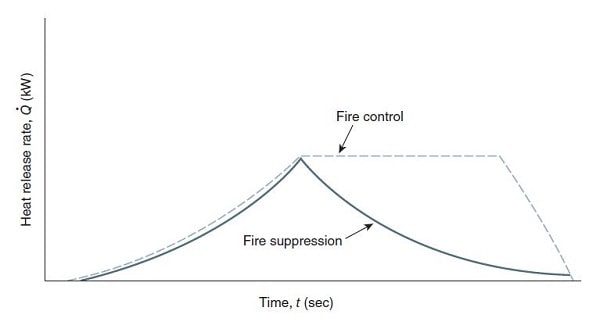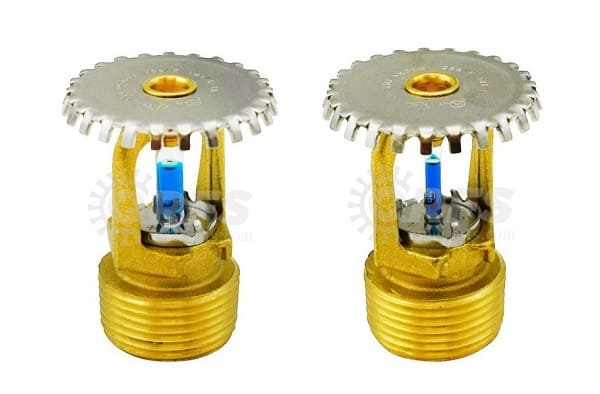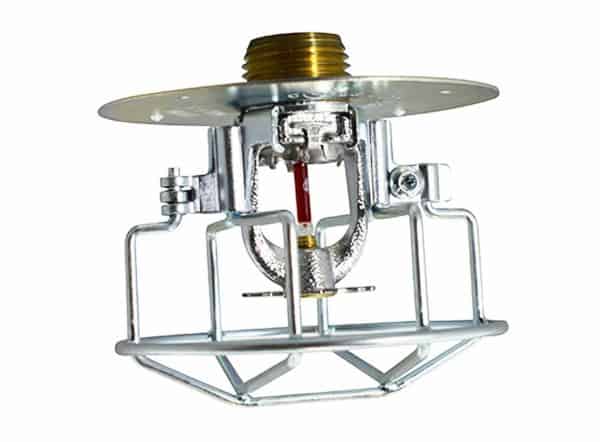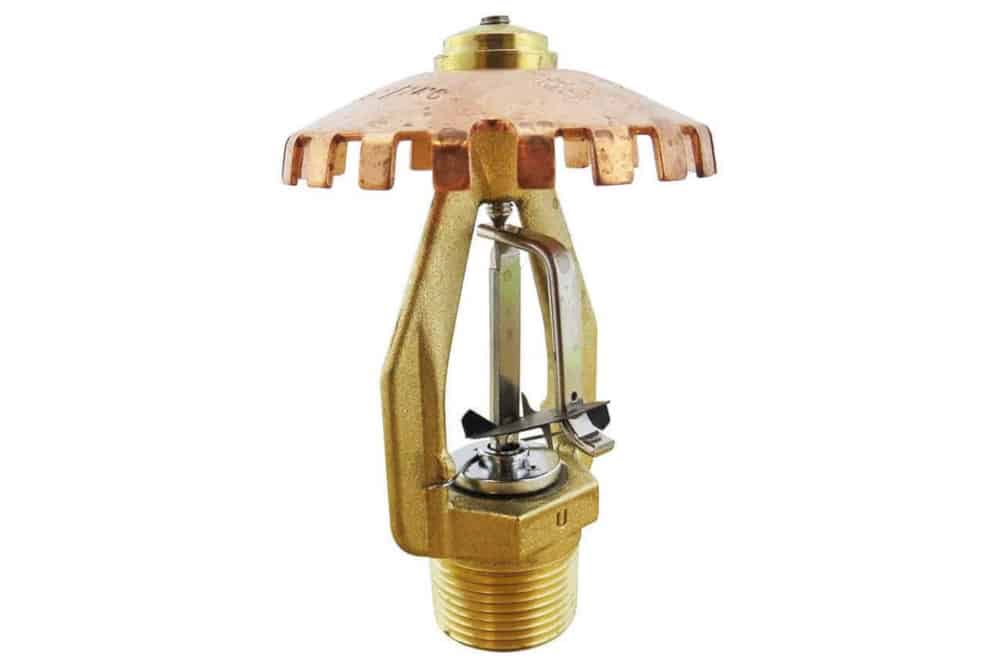ESFR sprinkler heads provide early fire suppression with a fast response
“ESFR” is only one of many acronyms in the alphabet soup of fire protection. But “early-suppression, fast-response” sprinklers are uniquely powerful tools for protecting high-challenge occupancies. Unlike many other sprinkler types, ESFR sprinklers are designed to suppress a fire, directly attacking the blaze rather than just controlling it.
Though they aren’t practical for every application, ESFR sprinklers are highly useful in many storage occupancies. And to properly maintain sprinkler systems in these settings and maximize warehouse space, it helps to know the basics:
- How ESFR sprinklers work
- The benefits of early suppression and fast response
- What building owners and managers should understand about obstructions, clearance rules, and other considerations
We’ll frequently refer to NFPA 13: Standard for the Installation of Sprinkler Systems (2022 edition) throughout this piece.
The QRFS has the parts you need for maintenance, repair, or new systems. Shop our ESFR sprinklers or contact us for a quote on other storage sprinkler models.
The basics of ESFR sprinkler systems
The rules for designing sprinkler systems for storage occupancies, including those using ESFR sprinklers, are some of the most complicated topics in NFPA 13. Fortunately, understanding how an ESFR sprinkler works is pretty simple—the name tells you what it does. But here’s what “early-suppression fast-response” means, exactly:
“Early suppression”—the sprinkler’s deflector is designed for suppression, not control
The words “early suppression” indicate that ESFR sprinklers are distinct from most other types of fire sprinklers. An everyday sprinkler, aka a “spray sprinkler,” is primarily meant to control the spread of a fire by wetting and cooling an area, depriving the fire of fuel and lowering heat. This action also helps prevent flashover, a deadly event where the gases in the room ignite suddenly. Spray sprinklers can completely put out a fire—and they often do—but that’s not their objective.
Instead of wetting and cooling an area to prevent a fire’s spread, ESFR sprinklers are designed to stop it as soon as possible—hence the name, “early suppression.” NFPA 13 defines fire suppression as:
From the 2022 Edition of NFPA 13
3.3.81 Fire Suppression. Sharply reducing the heat release rate of a fire and preventing its regrowth by means of direct and sufficient application of water through the fire plume to the burning fuel surface.
In ordinary language, fire suppression means attacking a fire directly by putting lots of water through the flames and on the burning fuel. This prevents the fire from growing or springing back to life after water application—often, putting it out completely.
However, note there is a third category beyond control and suppression: extinguishment. That means entirely and totally putting out a fire without requiring any firefighter ‘mop up,’ like searching for remaining hot spots and fuel sources that could reignite. In practice, sprinklers designed for control or suppression can and sometimes do extinguish a fire. But their design objectives (and ability to do so for different fires) are still technically distinct.

Several features of ESFR sprinklers make this possible. First, the sprinkler deflectors are designed to produce larger, heavier droplets that can penetrate a fire plume. You can learn more about what makes ESFR sprinkler heads (and other storage sprinklers) different in our previous blog.
Second, ESFR heads and the design of their systems directly apply water to a fire. Garner Palenske, P.E., explains that an ESFR spray pattern features extra water density within a two-foot radius of the sprinkler axis. In other words, the area directly below one of these sprinklers is getting hit with a lot of water.
Tight spacing also plays a role. NFPA 13 says ESFR sprinklers may protect light or ordinary hazard occupancies (14.2.7), where they can only be spaced up to 15 feet apart (10.2.4.2). But further rules state that ESFR sprinklers may only be spaced between 10 and 12 feet apart, depending on the ceiling height (14.2.8.2.1). This results in a high density of heads that stand ready to attack a fire.
Finally, ESFR sprinklers deliver a high volume of water flow, which is reflected by the pressure and water supply needed and the sprinklers’ K-factors, the size of the orifice where water comes out. NFPA 13 says that ESFR sprinklers must have a minimum K-factor of 11.2 (7.2.2.5), a very large opening. Beyond that minimum, the K-factors must be matched to the hazard level (7.2.2.6). This means that design challenges like protecting tall storage, high ceilings, and flammable goods are solved, in part, by increasing the size of the orifice and volume of water flow.
“Fast response”—the thermal element helps ESFR sprinklers activate quickly
ESFR sprinklers are also “fast-response” sprinklers, meaning that they have thinner, more-sensitive thermal elements. A fast-response element doesn’t change the temperature at which the sprinkler activates—that depends on the solder or the fluid in the bulb, not the size of the element. Instead, it allows the sprinkler to respond to temperature changes quicker.
As discussed in another blog, the fast-response element is not unique to ESFR sprinklers. Many commercial spray sprinklers have this feature and are called quick-response sprinklers. Likewise, residential sprinklers are fast-response. Increased heat sensitivity is desirable in many applications designed to protect life and property.
The fast-response element of an ESFR sprinkler makes early suppression possible. To understand this, consider why firehoses need to have so much pressure behind them. As the 2019 edition of the NFPA 13 Handbook explains, a fire can vaporize small water droplets and produce air currents that push water away once it reaches an appreciable size (3.3.205.4.5). Thus, ESFR sprinklers need fast-response elements because fire suppression must happen early—before a blaze gets too big.

The benefits of ESFR sprinklers
An ESFR sprinkler system has several advantages over its standard spray counterparts in the right situations. The early suppression function prevents fire damage, and suppressing the fire quickly can mean less water damage overall, especially when fire hoses get into the picture. But where ESFR sprinklers really shine is handling challenges that other storage sprinklers can’t—often, without the need for in-rack sprinklers embedded in storage racks.
With a large amount of densely packed and often highly flammable fuel, warehouses can be very difficult to protect with fire sprinklers. A hot and fast-growing fire is possible and even likely in these settings. And as mentioned in the previous section, large fires can vaporize and blow away water droplets from sprinklers. In addition, the NFPA 13 Handbook (3.3.205.4.5) describes how hot, fast fires may cause premature activation of adjacent sprinklers, reducing the effectiveness of the nearest sprinkler by lowering available water pressure.
For specific situations, NFPA 13 often requires other types of storage sprinkler systems (CMDA or CMSA) to include in-rack fire sprinklers. As their name indicates, in-rack sprinklers are installed in the storage racks of warehouses so that sprinklers are very near potential fires. It’s an effective strategy—but not very convenient or flexible. In-rack sprinklers require cages to protect them from damage and shielding from the spray of other nearby sprinklers. Plus, an in-rack system has dedicated risers and branch lines that have to run through the racks and be decommissioned and rebuilt if the shelving is rearranged.

Perhaps the biggest benefit of ESFR sprinklers is that they can handle some high-challenge fire protection environments without the need for inflexible in-rack sprinklers. But NFPA 13 has a host of unique rules for using ESFRs, many of which are designed to prevent obstructions.
Water supply, height, and obstruction considerations
Designers and the building owners who approve a project consider some key elements before using ESFR heads. Chief among them are water supply requirements and obstruction and maximum height rules.
In certain situations, combinations of in-rack sprinklers with either standard spray or ESFR sprinklers on the ceiling may be ideal. And sometimes, designers and building owners opt for an in-rack plus standard-spray-ceiling combination to avoid the expense of boosting the available water supply for ESFRs. As we covered in our piece on sprinkler system design, designers use hydraulic calculations to determine the pressure and flow needed to meet “the most hydraulically demanding area of the systems.” And ESFRs need a great deal of pressure and flow.
Then, there are clearance rules. Remember, ESFR sprinklers target fires right below them, which means they are susceptible to obstructions that block their spray. Water droplet size and the geometry of their spray pattern must be maintained. That’s why Chapter 23 of the NFPA 13 Handbook (2022 edition) begins with a warning: “special attention [must be] given to avoidance of objects that could obstruct sprinkler spray patterns.”
Lights, fans, ductwork, pipes, conduits, beams, columns, catwalks, and other warehouse features can all present a challenge. Designers can avoid or work around these features in many system types, but ESFR sprinklers have unique demands. Chapter 14 of the NFPA 13 Handbook specifies that “Many obstructions that can be tolerated for other types of sprinklers are unacceptable where ESFR sprinklers are used.”
In addition, there are interrelated maximum ceiling and storage height requirements that ensure ESFR sprinklers will do their job—too much distance can compromise droplet size and effectiveness. The rules vary based on the types of commodities stored (e.g., Group A plastic, rubber tires, or roll paper) and whether storage is palletized, sold-piled, or rack.
The requirements are too numerous to cover here completely. But these storage and ceiling height specs for the “Protection of Exposed Expanded Group A Plastics” (23.4) are one example:
From the 2022 edition of NFPA 13
23.4.2 The maximum storage height shall be 35 ft (10.7 m).
23.4.3 The maximum ceiling height shall be 40 ft (12.2 m).
Thus, a warehouse storing that commodity in that arrangement with higher ceilings or storage racks than the maximum may require in-rack sprinklers or a combination of types.
A warehouse owner or manager doesn’t need to interpret all these complex rules—it’s a fire protection system designer’s job to ensure ESFR sprinklers have clearance and other vital elements in the initial system design. But warehouses are dynamic places, so beware of redesigns or new commodities that could cause obstructions or otherwise violate rules. When in doubt, always consult a qualified fire protection professional.
The below video shows an FM Approval test of a Viking ESFR sprinkler. It illustrates how fast fires can spread in warehouses and how ceiling-mounted ESFRs suppress one:
ESFR sprinklers are a powerful fire protection tool when used in appropriate storage settings
Again, an ESFR sprinkler is designed to suppress, rather than control, a fire. High water flow rates, large and dense water droplets, tight sprinkler spacing, a relatively straight-down spray pattern, and a fast-response element all make early suppression and fast response possible.
This capability is extremely valuable in warehouses, where densely and highly stacked goods create optimal conditions for rapid fire spread. And while in-rack sprinklers can also be a viable or required option, ESFRs may be a good choice, especially when facility managers want the flexibility to reconfigure warehouse racks.
Industrial property owners and managers can consider ESFR sprinklers to protect storage facilities in consultation with qualified fire protection professionals. But if you already have one of these systems, be careful about making changes that obstruct these sprinklers or present new fire challenges. And ask for expert help if you aren’t sure!
QRFS carries ESFR sprinklers and can get other models you need on request. Call us at +1 (888) 361-6662 or email support@qrfs.com for a quote or any other questions!
This blog was originally posted at blog.qrfs.com. If this article helped you, check us out at Facebook.com/QuickResponseFireSupply or on Twitter @QuickResponseFS.



Can I use ESFR sprinkler heads for a residential area e.g., a coupe of office and office corridor?
Erhan — technically, ESFR sprinklers can be used in light or ordinary hazard occupancies since the 2013 edition of NFPA 13. But we believe this guidance was intended for their use in spaces already otherwise protected by ESFR systems, like offices within a warehouse. If you’d like a fire protection pro to research this to provide a definitive answer for the specific application you are thinking of, you can try our Ask a Fire Pro service. Click the link to submit your question with some information about your building and system, and a fire protection professional will provide an answer based on best practices, standards, and codes. Our pros include AHJs, contractors, engineers, and code experts with 150+ years of combined experience!
Thanks for the information – we have pallets that are stacked high in our facility. Would ESFR Sprinkler benefit our setup? Also what should the clearance between the stacked pallets be?
Alex — They very well might, but the NFPA 13 rules on protecting high-piled storage, including various clearances, sprinkler types and spacing, etc. are pretty complex. Your best bet is to contact a qualified fire protection pro (ideally, a designer) to evaluate your specific situation and propose the best options. Thanks for reading!